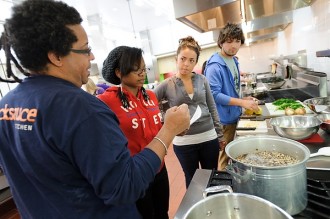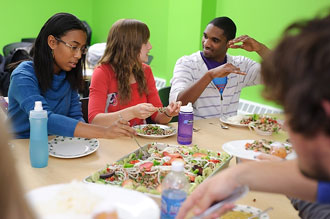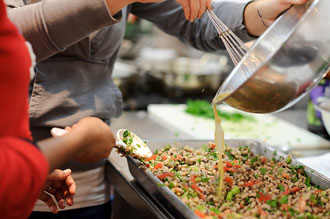Popular UW–Madison program for first-year students continues to grow
Scott Barton, a New York-based chef, is no stranger to his role as kitchen commander. He bounces around the room, correcting techniques, dispensing trivia about palm oil and tapioca, and finding jobs for anyone who’s been idle a bit too long for his taste.

Working with hands-on tutelage by New York-based chef Scott Barton, (pictured at far left), undergraduates in a First-Year Interest Group (FIG), “Tasting Food, Tasting Freedom,” prepare an authentic Brazilian meal in the Food Applications lab in Babcock Hall. The weekly dinner lab is part of a FIG class supported by Madison Initiative for Undergraduates funding and taught by Jack Kloppenburg, professor of community and environmental sociology.
Photo: Jeff Miller
But his sous-chefs are not highly — or even basically — trained, in most cases. Tonight he will help 20 freshmen at the University of Wisconsin–Madison to prepare an authentic Brazilian meal.
Master chefs they are not, and by the end of the night, at least one finger sports a bandage from a run-in with a knife, a stack of plates has shattered on the floor, and a fair amount of time has been spent picking shards of eggshell out of what will become a fried dessert. But the students are eager to learn — and to eat. And although most of their knife skills are years behind Barton’s, within two hours, the daunting pile of leafy greens and exotic ingredients has been transformed, and the feasting begins.
It must be Tuesday. These students, participants in one of the university’s First-Year Interest Group (FIG) courses, meet in the basement of Babcock Hall weekly, with or without a visiting chef, to prepare a meal together. While they eat Greek salad or soul food, the class discusses topics on how food relates to society, from the Americanization of ethnic foods to sustainability.
The FIG program is a popular option among freshmen that integrates coursework in a specific focus area with a social experience. Typically, a FIG consists of about 20 students who enroll in the same three classes, forming a core group of students who meet several times each week and become a support network throughout the crucial first year of college.

After working to prepare the authentic Brazilian meal, students in the class sit down to enjoy the fruits of their labor and the company of their classmates.
Photo: Jeff Miller
The program began in 2001 with four pilot clusters and a simple goal: helping to ease the first-year transition on a large campus and creating a sense of community.
“For some of these kids, there are more students living in their residence hall than in their whole town — if they came from a small town in Wisconsin or Minnesota — and that can be very intimidating,” says FIG Program Director Greg Smith. “This is one way to create a small-college experience, a liberal-arts-college experience on a big campus.”
The program proved popular and grew steadily until 2009, when the Madison Initiative for Undergraduates provided funding for further expansion, more than doubling the offerings available to incoming students. This year, UW freshmen could choose among 58 FIGs during the fall semester, with an additional 10 slated for Spring 2012. Topics range from “Springsteen’s America” to “Contemplative Neuroscience: The Psychology of Wellbeing,” and Smith estimates that by the end of the year, about one in five first-year students will have taken part in the FIG program.
Just over 1,000 students are enrolled in FIGs this semester, with about 25 percent coming from targeted minority groups (compared to 9 percent of the freshman class) — highlighting the program’s dedication to diversity education.

Students in the class, taught by Jack Kloppenburg, professor of community and environmental sociology, work to prepare the weekly meal.
Photo: Jeff Miller
“Tasting Food, Tasting Freedom,” the FIG that includes the weekly dinner lab, also involves classes in nutritional science and sociology. These courses provide the background knowledge to fuel their spirited discussions, but according to Jack Kloppenburg, a professor of community and environmental sociology who teaches the dinner lab, the experiential core of his class is what really sets it apart from many classes these students will take during their academic careers.
“We learn through a variety of different channels, but for a lot of our time at the university, we use only the aural channel,” he says. “There’s this whole other kinesthetic dimension — feel, touch, taste, all the senses. … It’s great to get a chance to use that.”
Aside from its sheer novelty, the program does, indeed, have measurable impact. During the last 10 years, students who participated in FIGs had a higher GPA at the end of their first college semester than those who didn’t. Smith attributes this to a variety of factors, including the chance to interact one-on-one with a professor early in a student’s college career, and the feeling of having “FIG family” to rely on.
The sense of community created by the program is felt throughout the dinner lab. There is no “Professor Kloppenburg” in this room; there is only “Jack.” Dishes are passed around the dinner table with familial ease. At a time when most freshmen are still struggling to find their niche, the voices in the room shift effortlessly from goading laughter to thoughtful debate. No matter the reason they originally joined the FIG program, now that they are here, they are completely comfortable in their surroundings.
UW student Kiernan McCoy says she originally chose this FIG because registering for three classes at once made choosing her classes easier, but since then, she has come to appreciate the program’s other benefits.
“Even next semester, we’ll have this base of people if we need help studying or just want to get together or something,” she says.
“I never had that big of a connection with food at all, I never really thought about it,” she adds, pausing to separate the inedible stems from a pile of sliced okra. “But now that we talk about organics and sustainability and culture, I realize what a big part of the world it is. Not just America, [but] the world.”
Student Javier Barbosa-Mireles stirs the caruru, similar to jambalaya, and adds okra, ground shrimp, peanuts and cashews. He was attracted to this FIG not only because of the cultural and political issues it raises, but also the community. “Cooking together feels great. When everyone’s sitting down, sharing the meal you just prepared together, it’s a really powerful experience,” he says.
That’s exactly what Kloppenburg wants to hear. His main goal for the course is simple: “I want them to find additional pleasure in food,” he says. “And not just any pleasure. … The kind of pleasure that comes with the extra knowledge and context and knowing about the relationships behind the food you’re eating, as well as the flavor. It’s a really heavy experience, and food literally tastes different.”
Tags: learning



